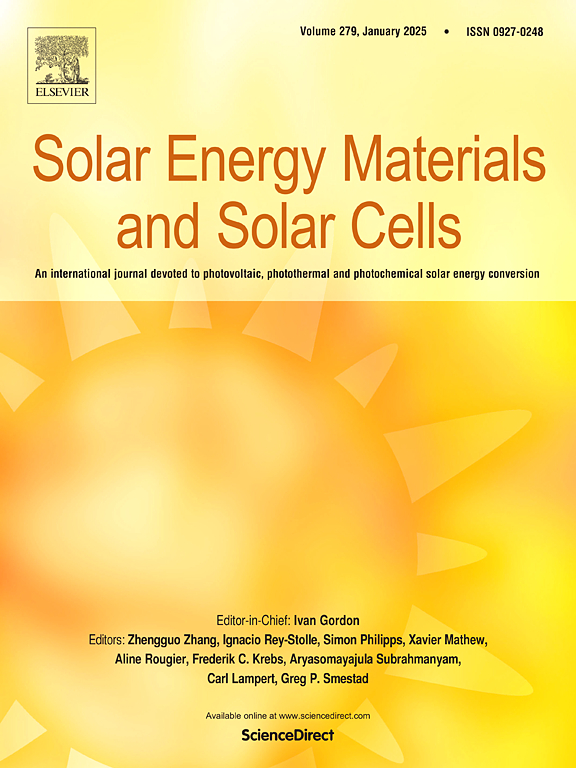Infrared optical properties of LaCoO3 thin films for thermal regulation in solar collectors
IF 6.3
2区 材料科学
Q2 ENERGY & FUELS
引用次数: 0
Abstract
The perovskite LaCoO3 can be used as a solar-selective layer in flat solar absorbers with an optimal thickness of approximately 600 nm. This thermochromic material is particularly well-suited for thermal regulation, with a significant increase in infrared emissivity occurring below the transition temperature. The optical properties of LaCoO3 thin films deposited by magnetron sputtering were analyzed using Fourier Transform Infrared (FTIR) spectroscopy, measuring transmittance and reflectance variations across the mid-infrared spectral range. The transmittance and reflectance variations were plotted at a wavelength of 8 μm as a function of temperature. By identifying an inflection point, the derivative pinpointed the maximum thermochromic effect at approximately 300 °C. This methodology also facilitated comparison with VO2-based selective coatings. Subsequently, a thermal camera was then employed to examine films of three different thicknesses, evaluated using two distinct methods. The first method consisted of plotting the infrared temperature measured by a thermal camera against the actual temperature. This technique highlighted the temperature dependence of the thermochromic effect in relation to film thickness. The second method, which accounted for all radiation contributions within the measurement environment, allowed the calculation of emissivity across Band III (7.5–13 μm). This approach revealed the onset of the thermochromic effect at approximately 80 °C for a film thickness of 551 nm.
太阳能集热器热调节用LaCoO3薄膜的红外光学性能
钙钛矿LaCoO3可以作为平板太阳能吸收器的太阳选择层,其最佳厚度约为600 nm。这种热致变色材料特别适合于热调节,在转变温度以下发生红外发射率显著增加。采用傅里叶变换红外光谱(FTIR)对磁控溅射法制备的LaCoO3薄膜的光学性能进行了分析,测量了薄膜的透射率和反射率在中红外光谱范围内的变化。在8 μm波长处绘制了透射率和反射率随温度的变化曲线。通过确定拐点,导数确定了在大约300°C时最大的热致变色效应。该方法也便于与基于vo2的选择性涂层进行比较。随后,使用热成像仪检查三种不同厚度的薄膜,使用两种不同的方法进行评估。第一种方法是将热像仪测得的红外温度与实际温度作图。这种技术突出了热致变色效应与薄膜厚度的温度依赖性。第二种方法考虑了测量环境中的所有辐射贡献,可以计算III波段(7.5-13 μm)的发射率。这种方法揭示了热致变色效应在大约80°C时开始,薄膜厚度为551 nm。
本文章由计算机程序翻译,如有差异,请以英文原文为准。
求助全文
约1分钟内获得全文
求助全文
来源期刊

Solar Energy Materials and Solar Cells
工程技术-材料科学:综合
CiteScore
12.60
自引率
11.60%
发文量
513
审稿时长
47 days
期刊介绍:
Solar Energy Materials & Solar Cells is intended as a vehicle for the dissemination of research results on materials science and technology related to photovoltaic, photothermal and photoelectrochemical solar energy conversion. Materials science is taken in the broadest possible sense and encompasses physics, chemistry, optics, materials fabrication and analysis for all types of materials.
 求助内容:
求助内容: 应助结果提醒方式:
应助结果提醒方式:


